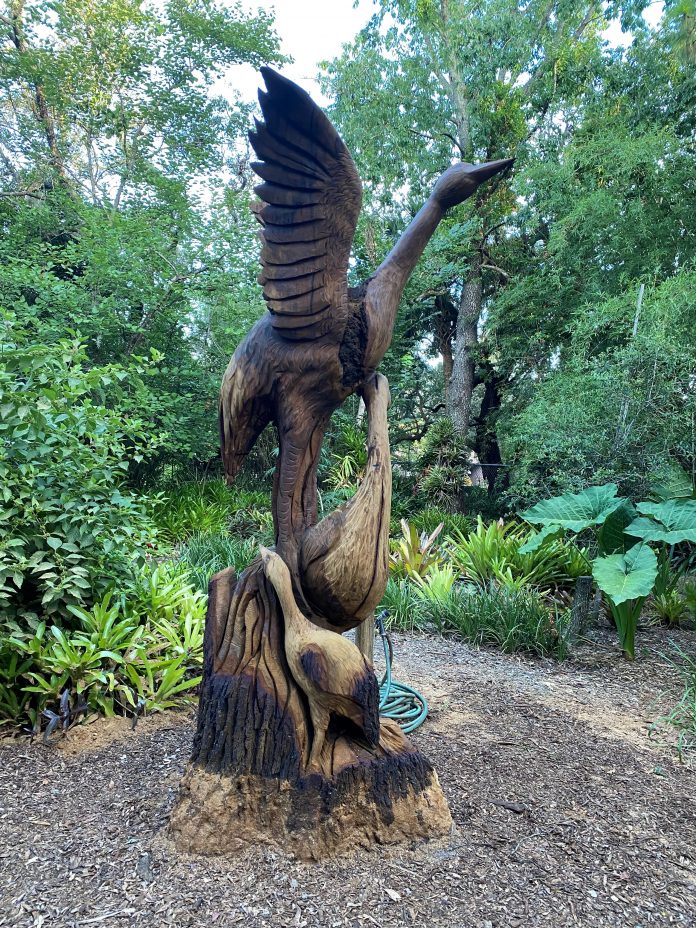A sublime artwork depicting a family of cranes at play, the beautiful, whimsical wooden sculpture gracing The Bromeliad Garden at Nature Coast Botanical Gardens is far more than a statue. It’s an extension and celebration of life itself.
As it turns out, the base material for this 12-foot-high timber sculpture is a landmark at the garden, 1489 Parker Avenue, Spring Hill. It’s an endangered landmark that now finds beautiful new life as a work of nature-made art. “Our centerpiece at The Bromeliad Garden was a tree that has grown there for more than 100 years,” said Mary Wuest, garden manager. “The tree lost a large limb last year, and the recent storms have taken it down.”
Faced with the extinction of a garden cornerstone, garden administrators opted to transform the remains of the tree into a standing, monumental work of art. “Natural art enhances the garden,” said Wuest, noting also the recent installation of fairy doors, a literal green thumb sculpture, decorative hangings, and a rain curtain in the garden.
For this particular artwork, garden administrators turned to a Homosassa artist renowned throughout the world for his nature-inspired masterworks. Gil Watson of Watson’s Art Gallery and Studio in Homosassa is the product of an artistic family who owned a woodcarving school in South Africa. By age 15, Martin was already winning awards for his painting, with his work appearing on national television. After opening his own woodcarving business, his products shipped nationwide as well as to Australia, Europe and the United States. His commissions included the carving of Corgi sculptures for the Royal family, carving front doors for the prestigious Kruger National Park, as well as carvings for large corporations. In 1991 Gil relocated to the United States, winning first place and best of show ribbons at art shows and counting as new clients Warner Bros., Clint Eastwood, and Gallo wineries. He was selected as the Artist-in-Residence at the Rocky Mountain National Park by the Dept. of the Interior.
Relocating to Florida to focus on marine-inspired painting and sculpture, he has revolutionized the Watson’s 3D System of natural art, with his gallery and studio serving as a showcase for his 3D products, a training center for his art instructors and a create space for many new products (https://gilwatson.com/about/).
Although he has completed 12 tree sculptures in the area, this marks Watson’s first such project in a botanical garden. “When I see the environment around me, I take it all in,” he said. “It is my inspiration. It’s like acknowledging the beauty around us.” Inspired by the vision of tropical cranes as they traipse the Florida landscape, Martin believed that a sculpture depicting a family of cranes seemed fitting for this particular work. “The family unit symbolizes the cycle of life,” he said.
Martin invested about 60 hours in this project, and sees the 12-foot-tall fruit of his labors as an act of conservation as well. “The sculpture comes from a 100 year old oak tree, instead of chopping it down, you can utilize it for something else,” he said.
Martin, furthermore, hopes that the botanical gardens will be utilized as a forum for artists who can display their work throughout the garden. “It would be great to have an art park at the botanical gardens,” he said. Ann Anderson, vice president of the Nature Coast Botanical Gardens, agrees that there is room for all sorts of ornamental beauty at the gardens, both natural and human made.
“We’re bringing in two new picnic pavilions, painted steel and metal with curtains, that will be perfect for weddings,” she said. Anderson credits the work of volunteers for putting in place the many objects of art, both grown and crafted, that make the garden beautiful. And about the tree sculpture she says, “People will be coming to the garden to see that sculpture for years to come.” Wuest agrees. “Now we get to keep our tree,” she said, “In a new, magnificent form.”

